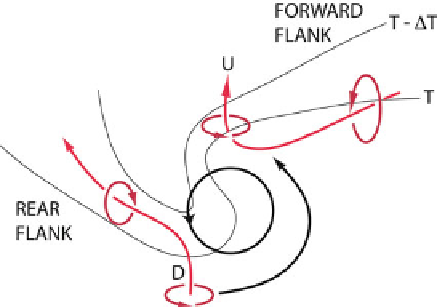Geoscience Reference
In-Depth Information
Figure 6.32. Idealized illustration showing how baroclinically generated horizontal streamwise
vorticity in the forward flank of a supercell can be tilted in the updraft and stretched under-
neath the updraft, and how baroclinically generated horizontal anti-streamwise vorticity in the
rear flank can be tilted by the downdraft and advected around the mesocyclone at the surface
and stretched underneath the updraft. Isotherms denoted by thin solid lines and labeled at T
and T
D
T; streamlines denoted by heavy lines with arrows; three-dimensional vortex lines
shown in red, with sense of rotation indicated by curved red lines with arrows. This diagram is
shown for illustrative purposes only and does not necessarily represent what is found in every
supercell. See also
Figure 4.15
.
may be brought down to the surface; if
e
does not change with height (i.e., if the
lapse rate is moist adiabatic), then the temperature at the surface in saturated air
cannot be changed by descending air parcels.
The baroclinic generation of horizontal vorticity depends not only on the
trajectories of air parcels passing along baroclinic zones, but also on the length of
time the air parcels pass over baroclinic zones. If the wind speed is too strong,
then air parcels do not reside in the baroclinic zone long enough to acquire high
values of horizontal vorticity; if the wind speed is too weak, then air parcels may
take so long to acquire horizontal vorticity that disruption from new surges in
outflow created when new pulses of updraft and the subsequent production of
precipitation occur, and modify the nature of the baroclinic zone and disrupt the
updraft. George Bryan at NCAR and Leigh Orf at Central Michigan University
have recently found evidence in idealized numerical experiments that low-level
mesocyclogenesis is favored when the low-level shear vector is relatively large in
magnitude and oriented normal to the shear vector at higher altitudes (see insets
at upper left-hand corner of
Figure 4.14g)
. It is possible that stronger low-level
mesocyclones are produced because air parcels tend to produce horizontal
vorticity baroclinically under the FFD for a longer period of time than possible
when the low-level shear is not normal to the shear aloft. Or, it might be that
such a configuration of shear (i.e., low-level hodograph that bends at 90
) favors
an increase in the upward-directed perturbation pressure gradient force. The
dynamic and thermodynamic reasons for the bent hodograph effect as of 2011 are
still not well understood.

Search WWH ::

Custom Search